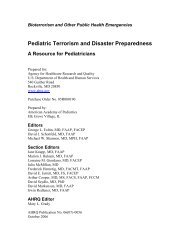H1N1 COUNTERMEASURES STRATEGY AND ... - PHE Home
H1N1 COUNTERMEASURES STRATEGY AND ... - PHE Home
H1N1 COUNTERMEASURES STRATEGY AND ... - PHE Home
You also want an ePaper? Increase the reach of your titles
YUMPU automatically turns print PDFs into web optimized ePapers that Google loves.
NBSB Pandemic Influenza Working Group<br />
Detailed Report<br />
<strong>H1N1</strong> <strong>COUNTERMEASURES</strong> <strong>STRATEGY</strong> <strong>AND</strong> DECISION MAKING FORUM <br />
HOSTED BY THE P<strong>AND</strong>EMIC INFLUENZA WORKING GROUP <br />
NATIONAL BIODEFENSE SCIENCE BOARD <br />
June 18–19, 2009 <br />
DETAILED REPORT <br />
INTRODUCTION TO DAY TWO<br />
Dr. Pavia explained that the second day would focus on defining the strategic goals for<br />
using diagnostics and antivirals against novel <strong>H1N1</strong> influenza. He asked participants to<br />
think about strategies from the public health perspective and the clinician’s perspective.<br />
DIAGNOSTICS<br />
Dr. Pavia said the quality of diagnostic data is key to all the scientific pillars of pandemic<br />
response: surveillance, diagnosis, mitigation, antivirals, vaccine, management of<br />
complications, and communication. Planners assumed the pandemic would begin outside<br />
the country, clinicians would do broad testing to identify its entrance into the United<br />
States, it would spread rapidly, and public health authorities would know who was<br />
affected. In reality, public health laboratories were swamped. The Centers for Disease<br />
Control and Prevention (CDC) bore most of the burden and did a good job getting<br />
diagnostic tools to labs, but local labs were not designed for such high throughput efforts<br />
and were hampered by low staffing and big financial cutbacks. The health care system<br />
has limited capacity in diagnostic testing for influenza: many institutions don’t stock<br />
diagnostic tests, and many clinicians don’t see the value in them. Novel <strong>H1N1</strong> spread<br />
rapidly with the seasonal influenza virus.<br />
The public health system must now monitor the severity of disease. Local resources have<br />
been taxed, and there is extensive confusion about diagnostic testing.<br />
Diagnostics play a role in public health. They can detect novel viruses and distinguish<br />
them from seasonal and other respiratory disease—which the new diagnostics did<br />
reasonably well for <strong>H1N1</strong>. They can be used to obtain virus for characterization. The<br />
contribution of diagnostics to providing accurate surveillance data is arguable. In the<br />
case of <strong>H1N1</strong>, it has been difficult to define the overall burden of disease, and surrogates<br />
may be needed to improve accuracy. Diagnostics can also bolster surveillance that<br />
identifies who is at risk for severe disease or death.<br />
<strong>H1N1</strong> was initially detected by a device developed under a contract with CDC—a direct<br />
result of Federal investment—and confirmed using the FDA-cleared CDC five-target<br />
influenza assay. Two cases were identified as a result of an ongoing study with the<br />
Department of Defense’s (DoD) Global Emerging Infections Surveillance and Response<br />
System. If we hadn’t been looking for pandemic influenza, Dr. Pavia said, it would have<br />
taken additional weeks to identify <strong>H1N1</strong>.<br />
While it has been difficult to determine the overall incidence of the disease, Dr. Pavia<br />
said we could certainly improve the accuracy of reporting of patients who were treated<br />
54
















